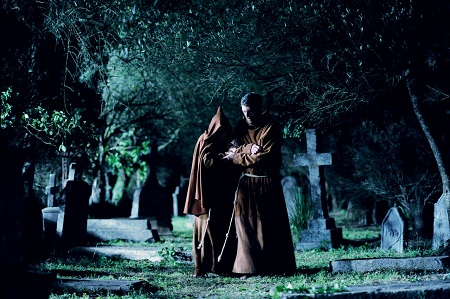The Monk (Dominik Moll, 2011): France
Reviewed by Alex Canzano. Viewed at The Santa Barbara International Film Festival.
 The story is set in the early seventeenth-century at the Capuchin Monastery just outside Madrid, and revolves around a prestigious Monk, known as Ambrosia (Vincent Cassel), who was abandoned as an infant, placed before the monastery doors to be pecked by vicious crows until being found, and adopted by the Capuchin friars. Now at the age of thirty, Ambrosia has acquired high esteem and admiration for his reputable sermons of which his monastery has gained considerable recognition for and people from all around travel long distances to hear them.
The story is set in the early seventeenth-century at the Capuchin Monastery just outside Madrid, and revolves around a prestigious Monk, known as Ambrosia (Vincent Cassel), who was abandoned as an infant, placed before the monastery doors to be pecked by vicious crows until being found, and adopted by the Capuchin friars. Now at the age of thirty, Ambrosia has acquired high esteem and admiration for his reputable sermons of which his monastery has gained considerable recognition for and people from all around travel long distances to hear them.
His irrefutable faith in God and his commitment towards virtue is unmarked until, while receiving a confession from an ambiguous man who claims to have molested his niece, Ambrosia unknowingly challenges Satan’s ability to corrupt by stating, “[He] has only the power we give to him.” The following day a masked figure, calling itself Valerio (Deborah Francois), arrives at the monastery requesting to be admitted. Against some of his peer’s approval, the monk grants Valerio’s admittance and from there, a chain of events that lure Ambrosia into temptation and deplorable sin– initiating his eventual descent into hell.
Adapted from Matthew Lewis’s classic novel published in 1796, writer/director Dominik Moll’s fourth picture-length film is a stylistic pastiche that condenses the original monastic story into a ninety-minute noir-ish feature. The Monk is pervaded with gothic imagery and clearly identifiable visual references to German expressionism and American Gothic-Horror. Some notable films of influence could be: F.W. Murnau’s Nosferatu (1922), William Friedkin’s The Exorcist (1973) Tobe Hooper’s Texas Chainsaw Massacre (1974) and certainly Bram Stoker’s Dracula (1992) directed by Francis Ford Coppola.

After Ambrosia suffers from a spell given to him by a poisonous insect bite he received while attempting to pluck a flower from his rose garden, the viewer is exposed to a surrealistic dream sequence—a strange and creepy montage of images– that is reminiscent to the work of Luis Bunuel. Bunuel co-wrote a previous adaptation of the story to film, which was also called Le Moine/The Monk and also released in France (1972).
Cinematographer Patrick Blossier’s highly formalized and expressionistic use of light/shadow reflects the psychological state of the characters, and emphasizes the themes of the text. Familiar edifices of the genre, such as the monastery that appears as a dark castle upon a large hill and elaborately decorated cathedrals, provide the main setting for the film. The gloomy scenery also features foreboding black crows perched upon biblical sculptures, a blanket of sunken fog drifting through a moonlit cemetery, with vine-covered tombstones and solitary dungeon cells infested with rats, skulls and bones.
While the film has its appeal, the story itself is rather predictable. All the themes seem too familiar and have already been explored countless times. The highly stylized visuals, while effective and commendable in particular moments, come off as being somewhat overstated in others. Vincent Cassel’s performance is solid as always but it would be fair to say that it did not require so much of him, considering his talents. He would benefit from taking on more challenging roles in the future. Overall the film doesn’t quite live up to what it promises, failing to make any sort of emotional or psychological impact, but still pleases certain aesthetic appetites and is an enjoyable experience nonetheless.
About this entry
You’re currently reading “The Monk (Dominik Moll, 2011): France,” an entry on Student Film Reviews
- Published:
- 02.01.12 / 9am
- Category:
- Films, Santa Barbara Film Festival 2012
No comments
Jump to comment form | comments rss [?] | trackback uri [?]